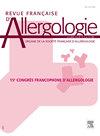Elevated inflammatory type 2 biomarkers at baseline predict multicomponent clinical remission following dupilumab treatment in patients with moderate-to-severe asthma
IF 0.3
4区 医学
引用次数: 0
Abstract
Prérequis/contexte
Clinical remission is an emerging treatment goal in asthma. Dupilumab, a fully human monoclonal antibody that blocks signalling of IL-4/13, key and central drivers of type 2 inflammation, is efficacious in patients with moderate-to-severe asthma.
Objectifs
This post hoc analysis evaluated the association between baseline blood eosinophil (Eos) and fractional exhaled nitric oxide (FeNO) levels and the likelihood of achieving clinical remission during QUEST (NCT02414854) in patients with moderate-to-severe asthma.
Méthodes
Patients who completed QUEST and subsequently enrolled in TRAVERSE (NCT02134028) were included. In QUEST, patients received either add-on dupilumab 200/300 mg or placebo q2w for 52 weeks. Remission was defined as meeting the following criteria at QUEST week 52: no exacerbations or oral corticosteroid use during QUEST, stable (decrease in pre-/post-bronchodilator forced expiratory volume in 1 second < 5% from baseline) or improved lung function, and 5-item Asthma Control Questionnaire score <1.5.
Résultats/discussions
At week 52, 38.3% (n = 387) of dupilumab and 26.2% (n = 136) of placebo recipients achieved remission. The likelihood of achieving remission was significantly higher for dupilumab vs placebo when baseline Eos was ≥ 150, ≥ 300, or ≥ 500 cells/μL (OR [95% CI] 2.17 [1.64, 2.86], 2.74 [1.92, 3.92], 4.04 [2.45, 6.68], respectively; all P < 0.0001) but not <150 cells/μL; and when baseline FeNO was ≥ 20 (2.35 [1.74, 3.16]; P < 0.0001) and ≥50 ppb (2.26 [1.38, 3.70]; P < 0.01) but not < 20 ppb. Remission rates were significantly higher with dupilumab vs placebo in patients with the following baseline biomarker combinations: Eos ≥ 150 cells/μL and FeNO ≥ 20 ppb (2.63 [1.88, 3.66]; P < 0.0001), Eos ≥ 300 cells/μL and FeNO < 35 ppb (2.37 [1.41, 3.98]; P < 0.01), and Eos ≥ 300 cells/μL and FeNO ≥ 35 ppb (3.28 [1.98, 5.44]; P < 0.0001), but not Eos ≥ 150 cells/μL and FeNO < 20 ppb, Eos < 150 cells/μL and FeNO ≥ 20/< 20 ppb, or Eos < 300 cells/μL and FeNO ≥ 35/< 35 ppb.
Conclusion
In patients with moderate-to-severe asthma, baseline elevated Eos and FeNO levels, both alone and in combination, were associated with a higher likelihood of achieving remission after dupilumab treatment.
基线炎症2型生物标志物升高预测中至重度哮喘患者在dupilumab治疗后的多组分临床缓解
临床缓解是哮喘的一个新兴治疗目标。Dupilumab是一种完全人单克隆抗体,可阻断2型炎症的关键和中心驱动因素IL-4/13的信号传导,对中度至重度哮喘患者有效。目的:本事后分析评估了基线血嗜酸性粒细胞(Eos)和分数呼气一氧化氮(FeNO)水平与中重度哮喘患者在QUEST (NCT02414854)期间实现临床缓解的可能性之间的关系。完成QUEST并随后入组TRAVERSE (NCT02134028)的患者纳入研究。在QUEST中,患者每隔一周接受一次额外的dupilumab 200/ 300mg或安慰剂治疗,持续52周。缓解被定义为在QUEST第52周满足以下标准:在QUEST期间无恶化或口服皮质类固醇,稳定(支气管扩张剂使用前/后1秒内用力呼气量减少);(较基线降低5%)或肺功能改善,5项哮喘控制问卷评分为1.5。在第52周,38.3% (n = 387)的dupilumab接受者和26.2% (n = 136)的安慰剂接受者获得缓解。当基线Eos≥150、≥300或≥500个细胞/μL时,dupilumab获得缓解的可能性显著高于安慰剂(or [95% CI]分别为2.17[1.64,2.86]、2.74[1.92,3.92]、4.04 [2.45,6.68];所有P <;0.0001),而不是<;150 cells/μL;基线FeNO≥20时(2.35 [1.74,3.16]);P & lt;0.0001)和≥50 PPB (2.26 [1.38, 3.70];P & lt;0.01),但不是<;20磅。在以下基线生物标志物组合的患者中,dupilumab的缓解率显著高于安慰剂:Eos≥150 cells/μL, FeNO≥20 ppb (2.63 [1.88, 3.66];P & lt;0.0001), Eos≥300 cells/μL, FeNO <;35 PPB (2.37 [1.41, 3.98];P & lt;0.01), Eos≥300 cells/μL, FeNO≥35 ppb (3.28 [1.98, 5.44];P & lt;0.0001),但不包括Eos≥150 cells/μL和FeNO <;20 ppb, Eos <;150 cells/μL, FeNO≥20/<;20 ppb,或Eos <;300 cells/μL, FeNO≥35/<;35磅。结论:在中重度哮喘患者中,基线Eos和FeNO水平升高(单独或联合)与dupilumab治疗后获得缓解的可能性较高相关。
本文章由计算机程序翻译,如有差异,请以英文原文为准。
求助全文
约1分钟内获得全文
求助全文
来源期刊

Revue Francaise d Allergologie
Medicine-Immunology and Allergy
自引率
33.30%
发文量
349
期刊介绍:
La Revue Française d''Allergologie : un véritable forum pour faire connaître des travaux originaux et permettre la diffusion de l''information auprès de toutes les spécialités concernées par les pathologies allergiques. La Revue Française d''Allergologie (8 numéros par an) est au carrefour de nombreuses spécialités - dermatologie, pédiatrie, ORL, pneumologie, ophtalmologie, médecine interne - qui, toutes, ont à traiter des maladies allergiques. Les symptômes des allergies fondés sur des mécanismes communs sont le plus souvent associés et se succèdent chez un même patient. En forte progression depuis 20 ans, les maladies allergiques sont dans l''attente de perfectionnements et d''avancées thérapeutiques qui permettront aux nombreux patients qui en sont atteints de mieux vivre avec leurs allergies. La Revue Française d''Allergologie se veut donc un véritable forum de discussions et d''échanges entre tous les spécialistes confrontés aux pathologies
 求助内容:
求助内容: 应助结果提醒方式:
应助结果提醒方式:


